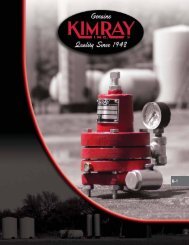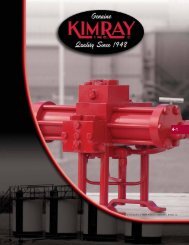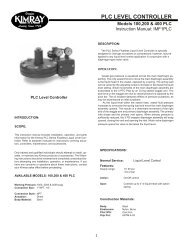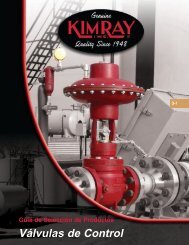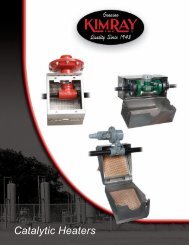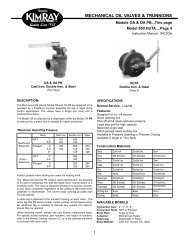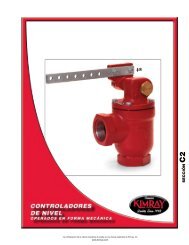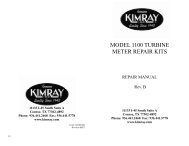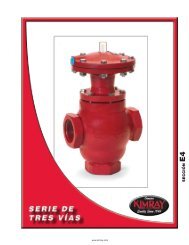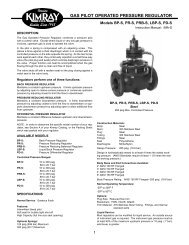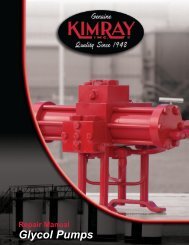Treater Valves - Home | Kimray Mobile
Treater Valves - Home | Kimray Mobile
Treater Valves - Home | Kimray Mobile
- No tags were found...
You also want an ePaper? Increase the reach of your titles
YUMPU automatically turns print PDFs into web optimized ePapers that Google loves.
TREATER VALVEModel SWABody, Connections & Pressure RatingsSize2” NPT 125 psig 8.6 bar150 FF 125 psig 8.6 bar3” 125 FF 60 psig 4.1 bar150 FF 125 psig 8.6 bar4” 125 FF 60 psig 4.1 bar150 FF 125 psig 8.6 bar6” 125 FF 60 psig 4.1 bar150 FF 125 psig 8.6 barINSTALLATION:BEFORE INSTALLATION:Be sure you fully understand the application, operation, and connectionof the device before installing.WARNING:Only trained personnel should install or service a control valve.Control valves and other control devices should be installed, operated,and maintained in accordance with international codesand regulations, manufacturer’s instructions, and proven bestpractices.Personal injury, equipment damage, property damage, leakage,or bursting of pressure-containing parts may result if the valveis overpressured or installed where service conditions could exceedthe limits given in the SPECIFICATIONS section.Overpressure protection should also be provided if the valve inletpressure may exceed the safe working pressure of the equipmentdownstream.To avoid injury or damage, install pressure-relieving or pressurelimiting devices to prevent service conditions from exceedingthose limits. Consult the appropriate code, regulations, or standards.Consideration should be given to the potential risk of injury orproperty damage due to escaping fluid. To avoid such risks, installthe regulator in a safe location.1.2.Inspect the openings in the valve for foreign material and clean thepipe lines to remove scale, chips, and debris.Install the valve with the arrow on the body pointing in the directionof flow. The arrow signifies that the device will operateproperly in the direction of flow indicated and willnot necessarily prevent flow in the opposite direction.The flow direction of the <strong>Treater</strong> Valve is down throughthe valve. If conditions indicate the possibilityof backward flow you may wish to install check valves.A person should never stand directly over or in front of avalve when the system is pressurized. Never look directly intoa valve in a pressurized system. The valve could suddenlyopen, blowing gas, dirt, metal particles, or other debris intothe person’s face and eyes.3.Install the valve using good piping practice. For flangedbodies use a suitable gasket between the body and thepipeline flanges. For threaded (NPT) bodies, use TFEtape or pipe thread sealant on external pipe threads.The FLANGE BODIES ARE NOT RATED TO THE ANSI CLASSPRESSURE. Do not install the valve in a system where the workingpressure can exceed valve body rating. CONNECTION RAT-ING CAN BE HIGHER THEN BODY RATING.24.5.Install gas equalizing line to 1/4” connection of drip pot. Do notshare this line with any other equipment.Adjust weight on lever arm, all the way out towards end of leverbar will achieve 4’ of liquid head, all the way in towards Hub assemblywill achieve 2’ of liquid head.
TREATER VALVEModel SWASTART-UP & TEST:With the installation completed and appropriate relief and check valvesinstalled and set, slowly open the upstream and downstream shutoffvalves. In order to test the function of the valve, allow only a small amountof upstream fluid to flow through the upstream shutoff valve. Check forproper valve operation by cycling the actuator arm several times.WARNING:Before performing any service, be sure that the valve is fully isolatedand that all pressure upstream and downstream has been relieved. Usebypass valves or fully shut off the process.Never assume that a check valve is fully blocking the downstream line.Never tighten any fitting or the main connections to the valve while thereis pressure on the line.MAINTENANCE:Maintenance should be performed on a regular basis. An initial inspectioninterval of 12 months is recommended. Depending on the serviceconditions of the valve, the inspection interval may be decreased orincreased.WARNING: If the valve leaks fluid, it indicates thatservice is required. Failure to take the valve out ofservice immediately may create a hazardous condition.The valve can be repaired without being removed from the piping.Detailed repair instructions are available for your specific valve.Repair Kits are available. Consult the <strong>Kimray</strong> Catalog, Section E1, orthe packing slip which is enclosed with each valve for the correct RepairKit number.TROUBLE SHOOTING:INSPECTION SCHEDULE:SYMPTOMFluid leaking from stuffing boxValve leaks when closedErratic OperationValve BouncesWater on DiaphragmPOSSIBLE CAUSEStuffing box nut looseSalt crystals on stemTeflon packing wornTape or sealant stuck in valveSoft seat wornRemovable seat wornEither diaphragm off centerStuffing box nut too tightSoft seat leakingDiaphragms hardenedDownstream balancing port blockedPressure in vessel is not stableSharing the equalizing line withanother piece of equipmentEqualizing line is above level of diaphragm,run line below diaphragmlevel to drain valve.Infrequent draining of drip potValve Trim (Seat,and Stuffing Box)SealsBodyDrip PotInspect every 6 months under normal serviceand conditions. Under severe service conditionssuch as sand, corrosion, salt, or high pressuredrop, inspect every 2 months until a predictablepattern can be established. Check seating surfacewere ball meets cone seat for erosion. This couldcause valve to leak when shut.Should be replaced every time valve is disassembled.Check for cracks or if the seals feel hard.Under normal conditions, the body will last manyyears.Severe conditions will require inspection morefrequently. The body should be inspected everytime valve trim is inspected.Should be checked daily to prevent water overflowinto valve diaphragm.* Under severe operating conditions the following maintenance schedulewill not be adequate and a shorter time schedule may be required.3
TREATER VALVEModel SWA6



